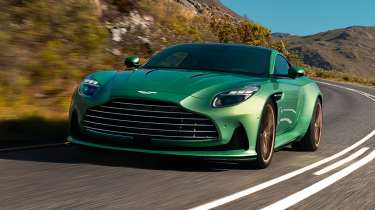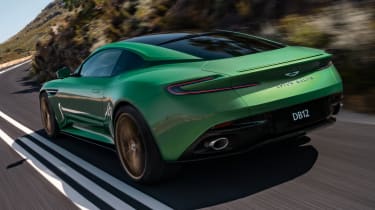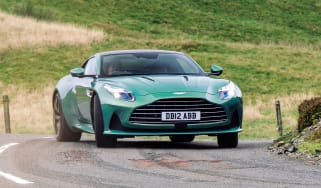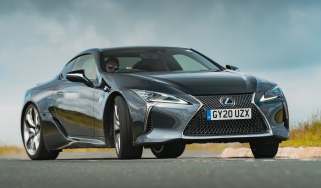2023 Aston Martin DB12 arrives with new design, interior and 671bhp V8
The first Lawrence Stroll era Aston Martin is here, with its sights firmly set on taking the fight to Bentley and Ferrari
It’s seven years since Andy Palmer revealed his first new car after taking the reins at Aston Martin, and now it’s Lawrence Stroll’s turn to reveal that car’s replacement: the DB12. It arrives with customers in quarter three later this year, will cost from £185,000 and signals the beginning of a new model offensive for the brand that will see eight new sports cars launched by 2026, including replacements for the Vantage and DBS.
Over 80 percent of the DB12 is new, from its more striking face to an overhauled interior and chassis. Wider and far more aggressive in appearance, the GT-looks have been ditched for performance (and ultra-luxury according to the AM). ‘Bold and assertive’, 'power and potency’ are dropped in through the press material and evidenced by the taller, wider front grill (machined from metal) and wider front and rear tracks covered in swollen haunches and pumped up arches. With 22mm added to the rear track and 6mm to the front the DB12 has a four-square, broad shouldered stance with more prominence and confidence than the more elegant DB11.
A pair of air curtains have been incorporated around the front wheels to reduce drag, and the new grill features larger apertures for engine and brake cooling. Its aerodynamic requirements are better integrated, too, from a front splitter that forms part of the car’s design flow and at the rear an aeroblade has been developed that’s deployed on demand.
Changes to the car’s extruded bonded aluminium structure are comprehensive. It is seven percent torsionally stiffer thanks to a new engine cross brace, thicker front and rear undertrays and a ‘garden gate’ brace positioned behind the radiator packs. There’s also a 140 percent increase in suspension top mount stiffness.
On the subject of suspension, considerable upgrades have been made to the car’s dynamic performance, predominantly to the adaptive dampers that have a much wider bandwidth and a 500% increase in force distribution. Double wishbones are used at the front with a multi-link set-up at the rear and revised damper calibration allows for improved response and better body control across the revised driver modes. Bushings, geometry, anti-roll bars and spring rates have all been upgraded too.
Further calibration of the electric power steering system, including the removal of the rubber isolators in the steering column, is claimed to provide more tactility through improved on-centre feel and a quicker, but natural rate of response. The ratio is constant at 13.09:1 with variable, speed sensitive assistance matched to the driver modes, with the assistance level dropping as you wind up through the more aggressive settings.
A new electronic rear differential is now in place and linked to the car’s stability control, which is classed as an intelligent system that anticipates what you’re doing rather than having to learn. It should, claims Aston Martin, make for a more intuitive, natural car in terms of dynamics and response rates.
New 21-inch forged alloy wheels are fitted with Michelin’s new Pilot Sport S 5 tyre, and Aston Martin has worked to create a bespoke compound just for the DB12. Behind the new wheels are the DB11’s 400mm and 360mm front and rear cast-iron brakes with a re-tuned booster. Carbon-ceramics offered as an option.
This substantial work beneath the DB12’s new bodywork is completed with an overhaul to the Mercedes-AMG sourced 4-litre twin-turbo V8 engine. Modified cam profiles, an 8.6:1 compression ratio - down from 10.5, larger turbos and increased and improved cooling result in peak power increasing to 671bhp and peak torque to 590lb ft (up 168bhp and 93lb ft respectively). As a result the cooling system has been improved with two auxiliary coolers fitted around the central radiator with a low temperature radiator also installed to the charge cooler water circuit. Improvements have also been made to the engine oil cooler and thermal airflow has also been improved by 56 percent.
The V8’s increased performance relies on an eight-speed automatic gearbox to manage drive to the rear axle via a carbonfibre prop and the new e-diff. With a shorter final drive ratio to improve acceleration - Aston claims a 3.5-second 0-60mph time and a 202mph maximum - the torque converter ‘box has improved shift feel and speeds to better suit the driver mode selected.
Those holding out for a V12 engined DB12 will be disappointed to hear that Aston Martin currently has no plans to fit the twin-turbo motor in its new Super GT car.
Some of the new hardware has pushed the car’s weight up, especially the additional bracing and extra engine cooling, but the forged wheels save nine kilos and the body stiffening has a neutral effect. Aston Martin quotes a 1685kg dry weight for the DB12 (the wet weight for a V8 DB11 was 1685kg), and the new car’s weight distribution is 48/52 front/rear.
Very few elements are carried over from the DB11’s interior. There remains a few Mercedes-Benz parts (the steering wheel for example) but there is an all-new, in-house developed HMI system produced by Best on Earth that has wireless Apple CarPlay, a touch screen and the company's own, bespoke graphics. Aston Martin is, understandably, very happy with the upgrade that consigns its ageing and wholly unsuitable Mercedes sourced system to the bin.
Aston Martin has also announced a partnership with audio specialists Bowers & Wilkins, with the firm's first bespoke sound system making its debut in the DB12. Available as an optional extra, the 1170w system features 15 speakers including 25mm aluminium Double Dome tweeters, 100mm Continuum mid-range units, unique spiralling diffusion channels and a host of trick sound treatment measures.
With a bold new centre tunnel design the DB12’s interior blends luxury and performance. The switchgear has a tactile feel to it and is laid out in a cabin that feels wider and more spacious than before and is a substantially more premium and indulgent place to be. The carbon sports seats, with their leather and Alcantara surfaces are a delight to be in and look at. Ferrari and Bentley will need to up their game.
Five years ago Aston Martin’s world took a turn for the worse following its IPO and associated financial downturn. A downturn that required a large amount of debt to keep the lights on while Stroll put in a team in place to right the wrongs, steady the business and set it on course for success. With Geely increasing its investment to become the company’s third largest shareholder, the Formula 1 team - owned by Stroll and sponsored by Aston Martin - securing works Honda engines from 2026 and now the DB12, those dark days could be starting to recede.











